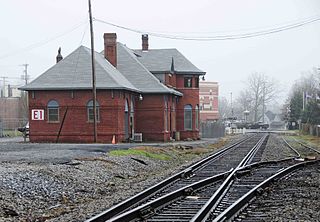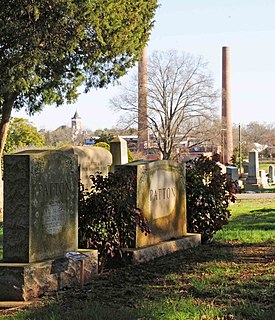
Charles C. Hartmann (1889–1977) was an American architect.

National Loan and Exchange Bank Building, also known as the Barringer Building, is a historic bank and office building located at Columbia, South Carolina. It was built in 1903, and is a 12-story, steel frame building faced in brick and stone. It measures 184 feet high and is considered Columbia's first skyscraper. The building was owned by the Barringer Corporation from 1953 until 1974.

First National Bank, also known as the National Loan and Exchange Bank Addition, is a historic bank building located at Columbia, South Carolina. It was built about 1924, and is a two-story, stone faced Neoclassical style building consisting of a two-story central section with flanking one-story wings. The front façade features four monumental 3/4 detached Doric order columns.

Union Downtown Historic District is a national historic district located at Union, Union County, South Carolina. The district encompasses 48 contributing buildings in the central business district of Union. The commercial, public, residential, industrial, and transportation-related buildings were built between about 1878 to about 1940, with the majority dating from about 1880 to about 1930. The district includes buildings representative of the Neo-Classical and Victorian styles. Notable buildings include the Union County Courthouse, Union Post Office/Federal Building, Flynn Building, Krass Building, People's State Bank/Arthur State Bank, Union Depot, Union Cotton Oil Mill, and Union Hardware Co. Located in the district is the separately listed Fair Forest Hotel.

Ebenezer Academy is a historic school building located at Rock Hill, South Carolina. It was built about 1860, and is a one-story, rectangular brick structure of simple design. The school was originally associated with Ebenezer Presbyterian Church until Rock Hill public schools were established about 1888 and was leased to York County for an elementary school. The school continued until 1950 when it was deeded back to the church. It is the oldest known school building standing in York County.

Tillman Hall, originally known as Main Building, is a historic academic building located on the campus of Winthrop University at Rock Hill, South Carolina. It was built in 1894, and is a three-story, red brick building in the Richardsonian Romanesque style. The building includes a basement and attic, has a combination gabled and hipped roof configuration, projecting bay windows, and features a conical-roofed clock tower with open belfry. In 1962, Main Building was renamed Tillman Hall for Governor and Democratic U.S. Senator Benjamin Tillman. Tillman Hall's Auditorium has hosted concerts by Frankie Valli and the Four Seasons in 1970, Jars of Clay in 1997, Florida's metal band Trivium in 2005, Celtic rock band Seven Nations in '05, Recycled Percussion in '07, and pop folk pianist Vienna Teng in 2008. The 2008 direct-to-video horror film Asylum was filmed outside of and inside Tillman Hall. The ending of the 1999 horror film Carrie 2 was also filmed at Tillman Hall.

Afro-American Insurance Company Building is a historic commercial building located at Rock Hill, South Carolina. It was built about 1909, and is a two-story, brick commercial building. The façade has a tan brick veneer, while the sides and rear are in red brick. It is an important surviving example of a commercial building related to the African-American community of the early-20th century.

Rock Hill Body Company, originally known as Victoria Yarn Mill # 2, is a historic industrial building located at Rock Hill, South Carolina. It was built about 1915, and is a two-story brick industrial building built as a textile mill. Later modifications include a one-story office addition and an elevator tower addition on the rear. It was the home of the Rock Hill Body Company, one of the earliest makers of truck bodies and school bus bodies in South Carolina, from 1938 to 1986.

Rock Hill Cotton Factory, also known as Plej's Textile Mill Outlets, Ostrow Textile Mill, and Fewell Cotton Warehouse, is a historic textile mill complex located at Rock Hill, South Carolina. The mill was built in 1881, and is a two-story, 12 bay by 16 bay, brick factory. It features a three-story tower at the main entrance. A number of additions have been made to the building. The Fewell Cotton Warehouse is a one-story, brick and wood frame warehouse built before 1894.

Bleachery Water Treatment Plant is a historic water treatment plant located at Rock Hill, South Carolina. It was built in 1930, and is a one-story brick building and filtration/purification facility in the Colonial Revival style. The city of Rock Hill passed a bond issue to build Bleachery Water Treatment Plant, to support the Rock Hill Printing and Finishing Company investment by M. Lowenstein Company of New York.

Laurelwood Cemetery is a historic cemetery located at Rock Hill, South Carolina. It was established in 1872, and was the first municipal cemetery of Rock Hill. It contains over 11,414 marked grave sites and includes variety of funerary art including a few raised stone tombs and a number of obelisks, table markers, spheres, and other forms. The cemetery also includes a Confederate monument and a memorial to veterans of the World War I.

Winthrop College Historic District is a national historic district located on the campus of Winthrop University at Rock Hill, South Carolina. It encompasses 17 contributing buildings and 1 contributing structure constructed between 1894 and 1943. Architectural styles represented include Gothic Revival, Richardsonian Romanesque, Classical Revival, and Colonial Revival. Notable buildings include the separately listed Tillman Hall and Withers Building, as well as Alumni House, Phelps Dormitory, Thurmond Building, Byrnes Auditorium, Johnson Hall, and the President's Residence.

Marion Street Area Historic District is a national historic district located at Rock Hill, South Carolina. It encompasses 28 contributing buildings and 1 contributing site in a middle-class residential section of Rock Hill. The bulk of the district developed between 1906 and 1925. Architectural styles represented include Victorian, Classical Revival, Colonial Revival, and Bungalow. Notable buildings include the Rawlinson House, McCall-Jones-Byrant House, Davis House, and W. B. Jenkins House.

Reid Street–North Confederate Avenue Area Historic District is a national historic district located at Rock Hill, South Carolina. It encompasses 22 contributing buildings in a middle-class residential section of Rock Hill. The district developed between about 1839 and 1935. Architectural styles represented include Victorian, Classical Revival, Queen Anne, and Bungalow. Notable buildings include the Steed House, Bynum House, Jenkins House, and Gross-Brock House, along with the separately listed White House.

Charlotte Avenue–Aiken Avenue Historic District is a national historic district located at Rock Hill, South Carolina. It encompasses seven contributing dwellings in the Oakland section of Rock Hill. The district developed between about 1891 and 1935. Architectural styles represented include Classical Revival, Queen Anne, and Bungalow. Contributing buildings are the Hughes Walker House, Paul D. Farris House, Roy Z. Thomas House, Wilson House, Armstrong-Mauldin House, and Bays-Blackman House.

Highland Park Manufacturing Plant and Cotton Oil Complex is a historic industrial complex and national historic district located at Rock Hill, South Carolina. It encompasses three contributing building and two contributing structures in Rock Hill. The complex includes the Highland Park Manufacturing Plant, the Highland Park Cotton Oil Mill (1902), and the Highland Park Cotton Oil Mill Office (1902). They are the surviving buildings of a larger complex, including a gin and seed house, the rest of which have been demolished. Surrounding the original mill are portions of the mill village. The mill operated until 1968.

Nation Ford Fish Weir is a historic fishing weir located near Rock Hill, South Carolina. It is one of the few relatively intact Native American fish weirs remaining in South Carolina. It is a double "V"-shaped rock fish trap or weir located in the channel of the Catawba River upstream from the railroad trestle at Nation Ford. The weir is located near the Nation Ford Road crossing point of the river and to several documented Catawba people villages.

First National Bank, also known as Carolina First Bank, is a historic bank building located at Greenville, South Carolina. It was built in 1938, and is a 2 1/2-story, sandstone sheathed steel frame Art Deco building. The building was enlarged in 1952. The building features a polished black granite door frame and base, a geometric-patterned cornice and a frieze band, stylized sunburst aluminum grill work, and fluted aluminum pilasters topped with stylized aluminum eagles.

West End Commercial Historic District is a national historic district located at Greenville, South Carolina. It encompasses 15 contributing buildings in Greenville's second "downtown." The commercial buildings primarily date from about 1880 to 1920, and include examples of Victorian commercial architecture. Notable buildings include the American Bank, Alliance and Mills & McBayer Cotton Warehouses, Indian River Fruit Store, Pete's Place, Bacot's West End Drug Store/Stringer's Drug, Furman Lunch, and Greer Thompson Building.

Weaving Room of Crossnore School, also known as Home Spun House, is a historic school building located at Crossnore, Avery County, North Carolina. It was built in 1936, and is a 2 1/2-story, banked, vaguely Rustic Revival-style building constructed of randomly mortared river rock. It was built to house the weaving program of the Crossnore School, an orphanage with an industrial and vocational training program.



























